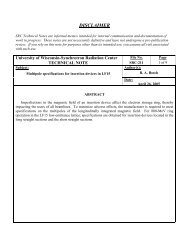SRC Users' Meeting - Synchrotron Radiation Center - University of ...
SRC Users' Meeting - Synchrotron Radiation Center - University of ...
SRC Users' Meeting - Synchrotron Radiation Center - University of ...
Create successful ePaper yourself
Turn your PDF publications into a flip-book with our unique Google optimized e-Paper software.
ATOMICALLY UNIFORM THIN FILMS ON SILICON<br />
M. Upton, T. Miller, and T.-C. Chiang<br />
Department <strong>of</strong> Physics, <strong>University</strong> <strong>of</strong> Illinois at Urbana-Champaign, 1110 West Green Street,<br />
Urbana, Illinois 61801-3080<br />
Frederick Seitz Materials Research Laboratory, <strong>University</strong> <strong>of</strong> Illinois at Urbana-Champaign,<br />
104 South Goodwin Avenue, Urbana, Illinois 61801-2902<br />
The continued miniaturization <strong>of</strong> silicon-based electronic devices is pushing component<br />
layer thicknesses toward the nanoscale, and a critical hurdle along this path is atomistic<br />
fluctuation. An uncertainty in layer thickness or roughness at the monolayer level can lead to<br />
substantial and unacceptable property variations. The effect is generally on the order <strong>of</strong> 1/N,<br />
where N is the thickness <strong>of</strong> the film in terms <strong>of</strong> monolayers (ML). At the nanoscale, 1/N can be<br />
as large as 20%, and for a typical valence band width <strong>of</strong> ~10 eV, the resulting changes in the<br />
electronic structure can be severe or even catastrophic for device performance. Exact control <strong>of</strong><br />
layer thickness and atomic uniformity is thus a critical issue, but so far has not been achieved for<br />
films grown on silicon. Yet this is extremely important in view <strong>of</strong> the vast technological and<br />
manufacturing base for the silicon industry. In this work, we show that Pb deposition on Si(111)<br />
at 100 K can lead to atomically uniform thin films provided that the Si substrate is pretreated<br />
appropriately. The resulting films support quantum well states [1-3] due to confinement <strong>of</strong><br />
electrons in the Pb films by the band gap in the Si substrate. A measurement <strong>of</strong> such states by<br />
angle-resolved photoemission determines the film<br />
thickness and reveals a quantum electronic structure<br />
that varies substantially as the film thickness<br />
undergoes monolayer changes. The result is a rather<br />
dramatic contrast between films consisting <strong>of</strong> even<br />
and odd numbers <strong>of</strong> monolayers. These findings<br />
illustrate the importance <strong>of</strong> atomic layer precision for<br />
controlling the electronic structure <strong>of</strong> thin films.<br />
Our angle-resolved photoemission measurements<br />
were performed at the <strong>Synchrotron</strong> <strong>Radiation</strong><br />
<strong>Center</strong>, <strong>University</strong> <strong>of</strong> Wisconsin-Madison, using a<br />
Scienta analyzer equipped with a two-dimensional<br />
detector. The Si(111) substrates were prepared from<br />
commercial n-type wafers with a resistivity <strong>of</strong> 1-60<br />
Figure 1: The three-dimensional plot<br />
above shows the photoemission<br />
intensity as a function <strong>of</strong> Pb film<br />
thickness and binding energy<br />
relative to the Fermi level. Three<br />
major quantum well peaks are seen<br />
at thicknesses N = 5, 7, and 9. A<br />
weak resonance peak at higher<br />
binding energy is seen at N = 8.<br />
ohm-cm. The Pb films were prepared by sequential,<br />
incremental deposition at 100 K, and the<br />
photoemission spectra were taken with the sample at<br />
the same temperature. The three-dimensional color<br />
plot in Fig. 1 shows the normal-emission intensity as<br />
a function <strong>of</strong> binding energy and film thickness.<br />
Three major peaks, at binding energies <strong>of</strong> 0.40, 0.26,<br />
and 0.15 eV below the Fermi level, attain their<br />
maximum intensities at film thicknesses N = 5, 7, and<br />
9, respectively, while no such peaks are observed at
















